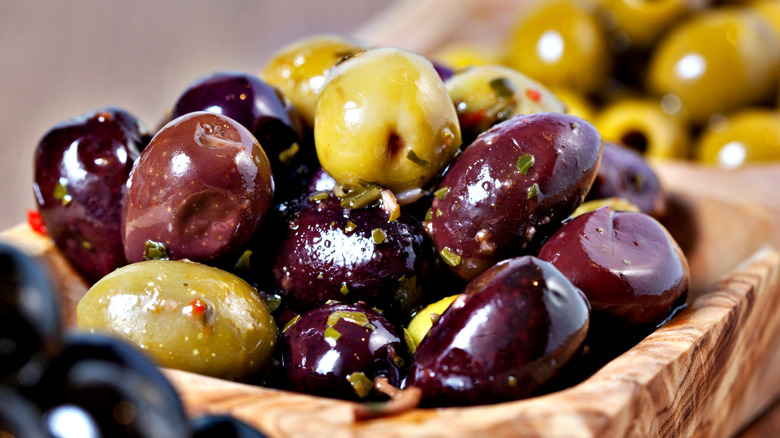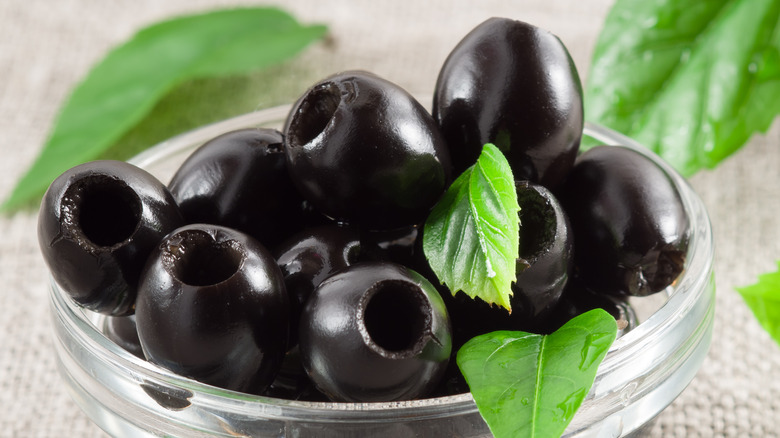Is There A Flavor Difference Between Pre-Pitted And Whole Olives?
Olives come in two categories: pitted and whole. What is the distinction? An olive, like peaches, nectarines, or cherries, is technically a stone fruit. Stone fruits are defined by the large, hard, central seed encased in the fruit's flesh and skin. With olives, the inner seed is referred to as the pit. Therefore, the difference between pitted and whole olives depends entirely on whether the olives in question do or do not have the inner seed.
There is a fair amount of debate about whether or not there is a difference in taste between pitted and whole olives. Purists — that is to say those who prefer their olives with pits intact — say that whole olives have a fuller, more complex flavor than their pitted counterparts. Everyone doesn't seem to care one way or the other. So, the question is, are the purists right?
The answer is a little more complicated that a simple right versus wrong scenario. The variety of olive is important, as green olives tend to be larger and tougher than black olives, and therefore react differently when pitted. Regardless of variety, however, the texture is the biggest difference between pitted and whole olives.
Texture is everything
The role of texture is very important to our perception of taste. Foods that are thicker and require more chewing, thereby slowing the rate at which flavor and aromas are released. Crisper foods too are often associated with salty and fatty flavors, which we all enjoy. Mushy or soggy foods, on the other hand, have the opposite effect. This is key to understanding the flavor differences between pitted and whole olives.
Because whole olives are not pitted, they will naturally maintain a firmer, rounded appearance. This is thanks to the pit, which is the central core the rest of the fruit is built around. Removing the pit automatically changes the texture of the olive. This is more drastic depending on whether you pit the olives yourself, or purchase them pre-pitted.
When you buy pre-pitted olives, they have been sitting in brine for a long amount of time. The brine enters into the cavity left by the removed pit and absorbs further into the olive flesh. The texture that results is one that is softer and far less chewy than the whole olives. Since whole olives do not have an open cavity, the brine does not penetrate as deeply.
As a result, whole olives pitted at home just before consumption have a meatier flavor and firmer texture. They take longer to chew, so you can really find the subtler flavors of the olive that may not be present in the pre-pitted alternative.
Is there a downside to pre-pitted olives?
There isn't so much a downside to buying pre-pitted olives as there is to know where and when they are best used. All olives are going to be salty because of the extensive curing process they go through. The fruit is packaged in brine for months in order for it to penetrate into the flesh of the olives and remove bitterness, while also developing flavor. Pitted olives get returned to the brine for extra seasoning, where the texture is loosened and the olives get an extra salty flavor.
The softer, pastier pre-pitted olives are great for making things like tapenades. The softer texture of the pre-pitted olives is easier to process and form into a paste. You also don't have the hassle of all the pits from the massive amount of olives required to make tapenade. Kalamata and other black olives often come pre-pitted. As they often get thrown into salads, sauces, and dips, their softer texture is a non-issue.
Whole olives you pit yourself are better served as an appetizer or snack. You don't need any fancy tools to do this, just a fair amount of dexterity. As the olives are front and center instead of blended together with other ingredients, you'll want the heavier textured olives that have more flavor, than just salt. It's a question of use more than anything else. In the end, your own preference will rule the day. Pitted or not, olives belong somewhere on the table.


